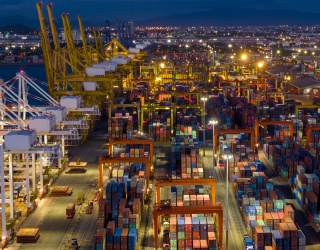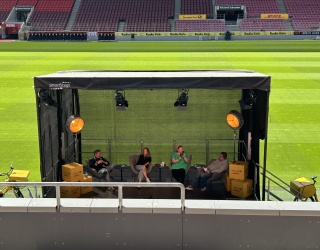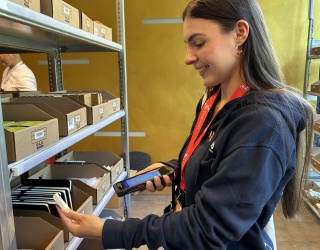
The eCommerce story is a success story. More and more products are being bought online. Yet one area online retail has not been able to conquer is food retailing. Dr. Bernhard Albert from the Foresight Solutions Institute for Future Research assists companies in innovation and strategic processes. In our interview, he talks about the future prospects for online food sales.
Dr. Albert, what specific challenges does online food retail pose for logisticians?
No matter what perspective you are looking at, whether that’s from a retailer’s perspective, a logistics perspective or from the customer’s point of view, logistics decides the future of online food sales. Three central challenges shape this development: regulations in the food safety area, added-value services expected by manufacturers and retailers and the transfer point at the end of the last mile.
With the expansion of online food sales, logistics service providers are frequently confronted not only with already packed and palleted foods, but also with the need to store or handle groceries themselves. Facilities, vehicles, transportation equipment and employees need to meet the legal requirements of food law. Continuous monitoring and supply chain and cold chain documentation is expected. Think about the deaths that were triggered by E. coli contaminated sprouts. Carriers and trucks were among the first to come under suspicion. Fortunately, it will become easier in the future to meet these requirements. On the one hand, this is due to innovative sensor technology and improved tracking and on the other, due to increasingly sophisticated protective packaging.
A bigger challenge is the subsequent customer demands at the interface between production and transportation. Logistics becomes the long arm of production. Nobody would for instance drive bottled wine in truly large quantities over freeways or oceans. This is done in flexitanks and the wine is later filled into bottles in bottling plants. The same is true for a variety of products. It would be simpler and often more cost-effective, if logisticians were to provide these value-added services themselves or offer them at their locations. This way they increase benefits and improve their margins. The market is highly dynamic and still offers a lot of room for intelligent solutions.
Another option is the packing of goods for end customers. Take a look at the typical shopping cart. In it, non-perishable and fresh foods are next to each other, combined with all kinds of different household items. The shopper is likely not going to split his/her household purchases in the future. With the advent of supermarkets, the customer turned into a picker, who assembles his/her own shopping basket. In online retail, this is done by machines and employees. However, online retailers and logisticians must not do what’s allowed for customer at the supermarket. Different products need to be in separate cardboard boxes and need to be treated differently until the transfer point.
How do these logistics differ from the logistics for eCommerce in other product categories?
To a large extent, they barely differ. Non-perishable foods for instance are delivered by courier delivery services like any other package. The main differences are the legal scope and the demands on employees. Added to this in the case of sensitive, fresh and frozen foods are handling, special forms of storing, special vehicles, quick turnover and transport as well as suited delivery concepts. Nobody wants meat from Italy or cheese from France that has been on the road one day too long or stood around in a hall, because a driver cancelled or the end customer was not at home. The current practice of some dispatchers will not prevail, because it neither meets the quality standards of the customer nor of food safety.
What foundations does logistics need to create for online food retail to be successful and come out on top?
When you take a look at supply chains in today’s food retail, they are quite efficient despite global transportation routes and high standards, ranging from agricultural producers in all countries of the world to global food markets all the way to retail. Every loading process, all used means of transportation, each fluctuation in temperature or humidity and even an unauthorized opening of loading space or outer packaging can be recorded.
Things then become quite delicate during the last mile. What is missing are storage areas where the goods are at least in the same good hands as in the supermarket. All too often, logisticians and recipients miss each other due to job and family demands and bad traffic situations. At best, this will only slightly improve given the increase in aging societies. In an otherwise very optimistic study by Ernst & Young, this is exactly what argues against online food orders for approximately three quarters of respondents.
Retail and logistics are currently taking a closer look at finding solutions. That said nobody is seriously expecting flying drones to deliver hot meals and ice cream in the future or for all households to be equipped with intelligent mailboxes or package mailboxes that expertly store fruits and vegetables, frozen products, pasta and canned goods. Those who are going to deliver feasible and efficient delivery concepts will win the race.
According to a current study by AT Kearney, even if many of them can imagine purchasing non-perishable foods online and are willing to pay an extra charge between 10-15 percent, 80 percent of customers want to be able to check fresh foods upon receipt. Subsequently an order is returned to the retailer because of a bad salad or damaged cucumber in the package. The economic damage is huge; the return transport alone devours margins. The same is true for the personal damage to the customer, who doesn’t want to wait several days for foods he/she needed. As long as fresh products and frozen foods continue to be purchased in brick and mortar stores, rice and pasta are not being ordered online.
How do you rate the development in this area over the next few years? Will online grocery shopping be in the same league as online retail in other product categories as far as market share is concerned?
The situation of brick and mortar food retailers is going to increasingly worsen. Competition today is already tough and the concepts that are meant to turn grocery shopping into an experience are only successful in a limited fashion. People want to eat with pleasure, but like to do without time-consuming shopping. Food subscription boxes for fruits and vegetables and store-based “click-and-collect“ services that enable control over pick-up or receipt are successful examples with only minor effects on logistics.
Not until retail and logistics present delivery or pick-up solutions, that ensure food gets to the customer in a fresh, appetizing and healthy manner will online food sales increase. Without this, it remains a niche market for delicatessen and spirits.
The second fundamental prerequisite is that the small retail margins are not devoured by expensive logistics and for logistics not having to relinquish any percentage of its already small margins to online retail. Online food retail subsidized by brick and mortar businesses and logistics, like the one we know from Great Britain is something nobody who wants to survive in the market is able to and shouldn’t be able to afford.
There is no market without profit – and those who burn themselves out too soon, run out of steam during the crucial last meters. At the moment, logisticians and retailers should prepare for their own market entry, determine their own desired position, develop promising concepts and choose the right entry point based on forward-looking analyses.
Interview: Daniel Stöter, iXtenso.com








